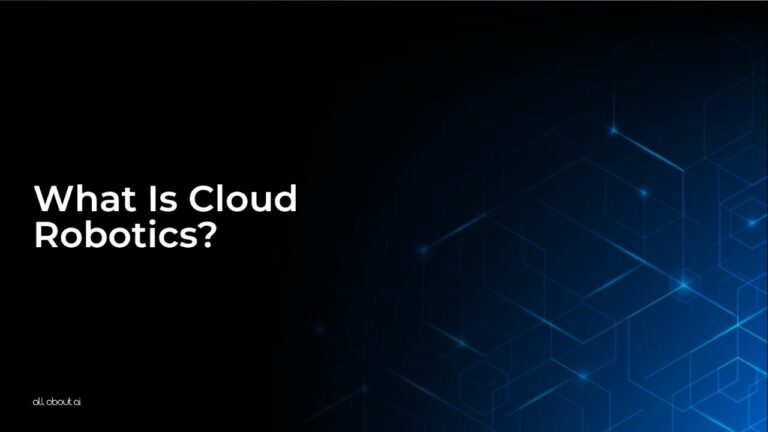What is cloud robotics? It represents the intersection of cloud computing and robotics, where robots are connected to a centralized cloud infrastructure, enabling them to access powerful computational resources, data storage, and advanced algorithms. This integration enhances the capabilities of robots by offloading resource-intensive tasks to the cloud, fostering more sophisticated and intelligent robotic systems.
Looking to learn more about cloud robotics and its use in various fields? Read this article created by the AI specialists at All About AI.
Examples of Cloud Robotics
In the realm of artificial intelligence, cloud robotics has found diverse applications. One notable example is in the field of healthcare, where robotic surgical systems leverage cloud resources for real-time data analysis, improving precision and decision-making during surgeries. Additionally, in autonomous vehicles, cloud-connected robots use shared data from the cloud to enhance navigation and safety protocols.
Another prominent instance is in industrial automation, where robots on factory floors access cloud-based analytics to optimize production processes. These real-world examples showcase the symbiotic relationship between cloud robotics and artificial intelligence, revolutionizing various industries.
Use Cases of Cloud Robotics
Medical Assistance: Cloud-connected robotic assistants in healthcare settings can access patient records, analyze medical data, and assist healthcare professionals in diagnosis and treatment.
Logistics and Warehousing: AI-powered robots in logistics benefit from cloud connectivity to efficiently manage inventory, plan routes, and enhance the overall supply chain.
Smart Agriculture: It enables precision farming through the provision of real-time data regarding soil conditions, crop health, and weather patterns. This serves to optimize various agricultural processes.
Education and Research: Cloud-connected robots facilitate collaborative research by sharing data and insights, accelerating progress in scientific fields.
Environmental Monitoring: Robots equipped with sensors can collect environmental data, which is then processed in the cloud for comprehensive analysis, aiding in environmental conservation efforts.
Pros and Cons
Pros
- Cloud robotics allows for easy scalability, enabling the integration of additional robots without the need for significant on-site infrastructure.
- Robots can tap into the cloud’s vast computing resources, empowering them to handle complex tasks and AI algorithms more efficiently.
- Cloud connectivity enables robots to receive real-time updates, ensuring they stay current with the latest algorithms and data.
- Initial costs for individual robots can be reduced as they leverage shared cloud resources, making cloud robotics a cost-effective solution.
- Cloud-connected robots can operate globally, fostering collaboration and knowledge sharing on a global scale.
Cons
- It heavily relies on internet connectivity, and disruptions can affect the real-time capabilities of robots.
- Storing and processing data in the cloud raises security issues, with the potential for sensitive information to be vulnerable to breaches.
- Depending on the network, there might be latency issues, impacting the responsiveness of robots and affecting critical tasks.
- Concerns arise regarding the privacy of data collected by cloud-connected robots, especially in sensitive areas such as healthcare.
- Implementing such a system requires a certain level of technical expertise, making the initial setup complex for some organizations.
FAQs
How does cloud robotics enhance the capabilities of traditional robots?
It extends the capabilities of robots by providing access to powerful computational resources and advanced algorithms in the cloud, enabling them to handle more complex tasks.
Are there any security risks associated with cloud-connected robots?
Yes, there are security concerns, as storing and processing data in the cloud make it susceptible to potential breaches. Implementing robust security measures is crucial.
Can cloud robotics operate without internet connectivity?
No, the cloud heavily relies on internet connectivity. While some basic functionalities may be possible offline, real-time and data-intensive tasks require a stable internet connection.
How does cloud robotics impact the cost of implementing robotic systems?
It can contribute to cost efficiency by allowing robots to share cloud resources, reducing the initial costs associated with individual robot setups.
Key Takeaways
- Cloud robotics integrates cloud computing and robotics, enhancing the capabilities of robots by providing access to advanced computational resources.
- Real-life examples demonstrate its application in diverse fields, from healthcare to logistics and agriculture.
- The pros include scalability, advanced processing power, real-time updates, cost efficiency, and global connectivity.
- Cons include dependency on the internet, security concerns, latency issues, privacy challenges, and initial setup complexity.
Conclusion
Cloud robotics seamlessly blends the power of cloud computing with the versatility of robotics. It has found its place in healthcare, logistics, agriculture, and beyond, illustrating its transformative impact on various industries. While offering scalability, advanced processing, and global connectivity, challenges such as internet dependency and security risks must be navigated.
This article aimed to answer the question, “what is cloud robotics”. For a deeper dive into AI and related topics, explore our comprehensive AI Handbook at All About AI. Stay informed and empowered as we navigate the dynamic landscape of artificial intelligence.





